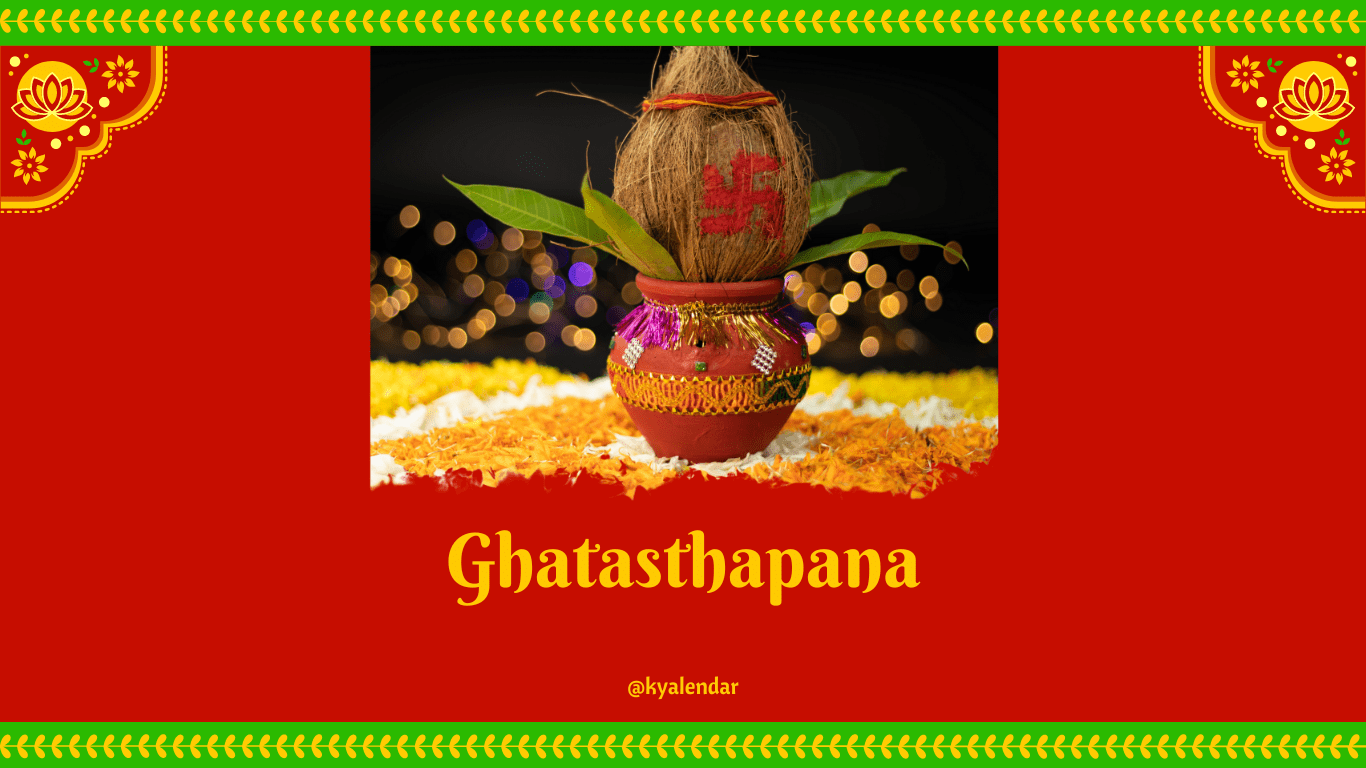
- This event has passed.
Ghatasthapana
October 3

Ghatasthapana marks the official beginning of Dashain, the longest and most celebrated festival in Nepal. It is observed on the first day of Navaratri, which is a nine-night celebration dedicated to Goddess Durga. In Nepali culture, Ghatasthapana is deeply rooted in tradition and spirituality, symbolising the start of a period where families come together to celebrate good over evil.
Rituals of Ghatasthapana
The word “Ghatasthapana” means “establishing the kalash,” which is a sacred pot symbolising Goddess Durga. On this day, the kalash is filled with holy water and placed in the prayer room or a designated sacred space. This pot is a representation of Goddess Durga, who is worshipped throughout Dashain. Alongside the kalash, a sand bed is created, and barley seeds are planted in it. The seeds are expected to grow into jamara, which is later used as offerings during Tika, the climax of Dashain.
The kalash and the jamara symbolise prosperity, strength, and blessings. Traditionally, the rituals are carried out by the male head of the family, though modern households may involve all family members in the process. The kalash is placed in a spot where sunlight does not reach, and it is watered daily until the ninth day, known as Navami. As the days progress, the barley seeds sprout into golden jamara, signifying growth and abundance.
Auspicious Timing
The process of Ghatasthapana has a specific time frame according to the lunar calendar. In Nepal, astrologers determine the most auspicious time for this ritual each year, ensuring that it aligns with the most favourable moments. People strictly follow this timing to maximise blessings and prosperity for their families.
Connection to Durga and the Navaratri
Dashain is a celebration of the triumph of good over evil, and it honours the victory of Goddess Durga over the demon Mahishasura. Ghatasthapana represents welcoming the goddess into one’s home. The nine days of Navaratri that follow are dedicated to different forms of Durga, with each day focusing on specific rituals and prayers. Devotees seek her blessings for protection, prosperity, and good health.
During this period, many people in Nepal observe fasting and make daily offerings to the kalash, symbolically worshipping the goddess. The atmosphere becomes spiritual and festive as homes are cleaned, decorated, and prepared for the coming days of celebration.
Cultural Significance
Ghatasthapana is more than just a religious ritual; it is a cultural event that brings families together. In Nepal, Dashain is a time for gathering with relatives, sharing meals, and enjoying the company of loved ones. The festival is associated with renewal, where people purchase new clothes, clean their homes, and prepare to receive blessings for the year ahead.
The planting of the jamara on Ghatasthapana carries its own significance. The growth of these tender plants is closely observed, and the state of the jamara is believed to reflect the fortunes of the family. Golden, healthy jamara is a good omen, while any issues in its growth are seen as potential challenges that might arise during the year.
Modern Celebrations
While the essence of Ghatasthapana remains rooted in tradition, modern Nepalese households sometimes adapt these customs according to their lifestyles. In urban areas, families living in smaller apartments may not have the space to plant large amounts of jamara, so they adjust the ritual accordingly. However, the reverence and dedication to the festival remain unchanged.
In schools and workplaces, the festive spirit begins on Ghatasthapana, with many institutions organising cultural programmes to mark the start of Dashain. Although the main holidays do not begin until later in the festival, the mood of celebration begins to set in from this day.
Ghatasthapana’s Impact on Society
As the first day of Dashain, Ghatasthapana also signals a pause in the otherwise busy routines of daily life. Schools, offices, and businesses start to prepare for the upcoming holidays. For many Nepali people working abroad, this time marks the anticipation of returning home to celebrate with their families.
Dashain is one of the few times in the year when entire communities come together, setting aside personal and professional commitments. Ghatasthapana is the symbolic door that opens up this period of unity and togetherness.
For farmers, this time of year holds particular importance. With the harvest season aligning with Dashain, the ritual of planting jamara represents the fertility and wealth that the earth brings. It is also a time for farmers to give thanks for their crops and seek blessings for future agricultural success.
Conclusion
Ghatasthapana is a day that holds deep meaning for the people of Nepal. It represents the start of Dashain, a festival that brings families together, reminds them of the values of good over evil, and encourages spiritual growth. The ritual of planting jamara and establishing the kalash is a symbolic act of devotion, prosperity, and renewal. Through this tradition, generations of Nepali people have maintained a connection with their cultural roots, passing on the importance of these customs to their children. As Dashain begins with Ghatasthapana, it sets the stage for days of joy, blessings, and unity.